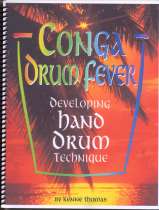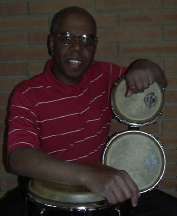This book helps address the issue facing many conga drummers. That is using both hands equally. The book has 100s of patterns, exercises and examples to develop your hand dexterity on a conga drum. With practice more drums can be included using the patterns in the various sections of the book. Included is cultural and historic information on hands drums related to conga drumming. A section on the Clave is also presented, supporting its focus in musica latina. Click here to view selected pages from the book.
The origin of the Conga is believed to have been with the Bantu people in the great Congo basin of West Africa. It was developed into the instrument we know today by the descendants of slaves brought to the plantations in Cuba. It is interesting to note that the name, Conga actually does not refer to the instrument but to the the dance which the drum is used for. The name given to the instrument in Espanol (Spanish) the language spoken in Cuba is, Tumbadora. All of the Conga drums, which we know and speak of in musical dialogue are various sizes of Tumbadoras. As the term conga has taken on a commercially generic recognition it is used here with qualification. Although originally hand constructed, as were their African predecessors, modern drums are machine tooled. Early drums were not uniformly made. Today conga drum sizes are 11 inches (approximately 28 centimeters), 11 3/4 inches (29.85 cm.), and 12 1/2 inches (31.75 cm.) in head diameter. There is an agreed upon standard for the height of 30 inches (76.2 cm.). This affords a comfortable disposition when you sit to play. They are now machine mechanism tuned by tension rods. Ascending in sizes from small to large the drums, los tumbadoras, have recognized names which also identify their tonal ranges; high to low.
The Conga player is known as the Conguero, or Congacero. They are the master of the instrument. The drummer must know how to use the many different playing maneuvers on the various sizes and how to draw the sounds out of the Conga. The conga player executes rhythms like the Tumbao, the repeated flexible conga drum rhythm pattern. Although this is a general term for conga, or Tumbadora rhythms it is usually associated with a particular rhythmic pattern and handing.
The method for playing the Conga drum has three basic sounds and also a conga specific hand maneuver. Good hand facility on a conga drum requires the ability to play all of these tones:
Conga Drum Fever Selected Pages
without the expressed written permission of Kenne Thomas or Kenzongs Music Pub. All book covers designed by Barbara Lyman at Alternative Designs All Rights Reserved. Copyright © 2004 - 2012 |




